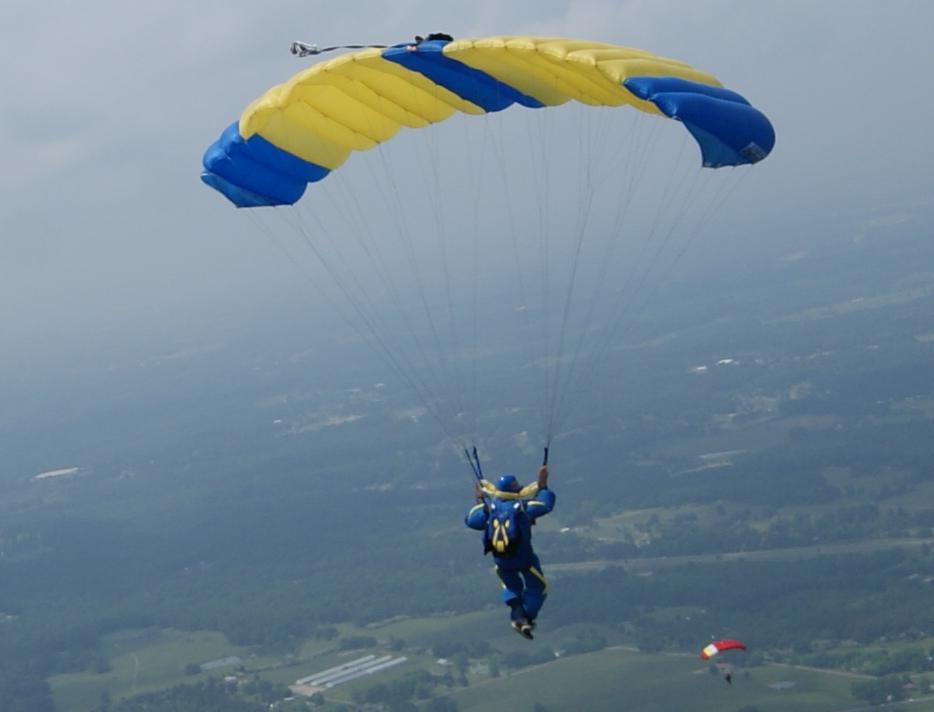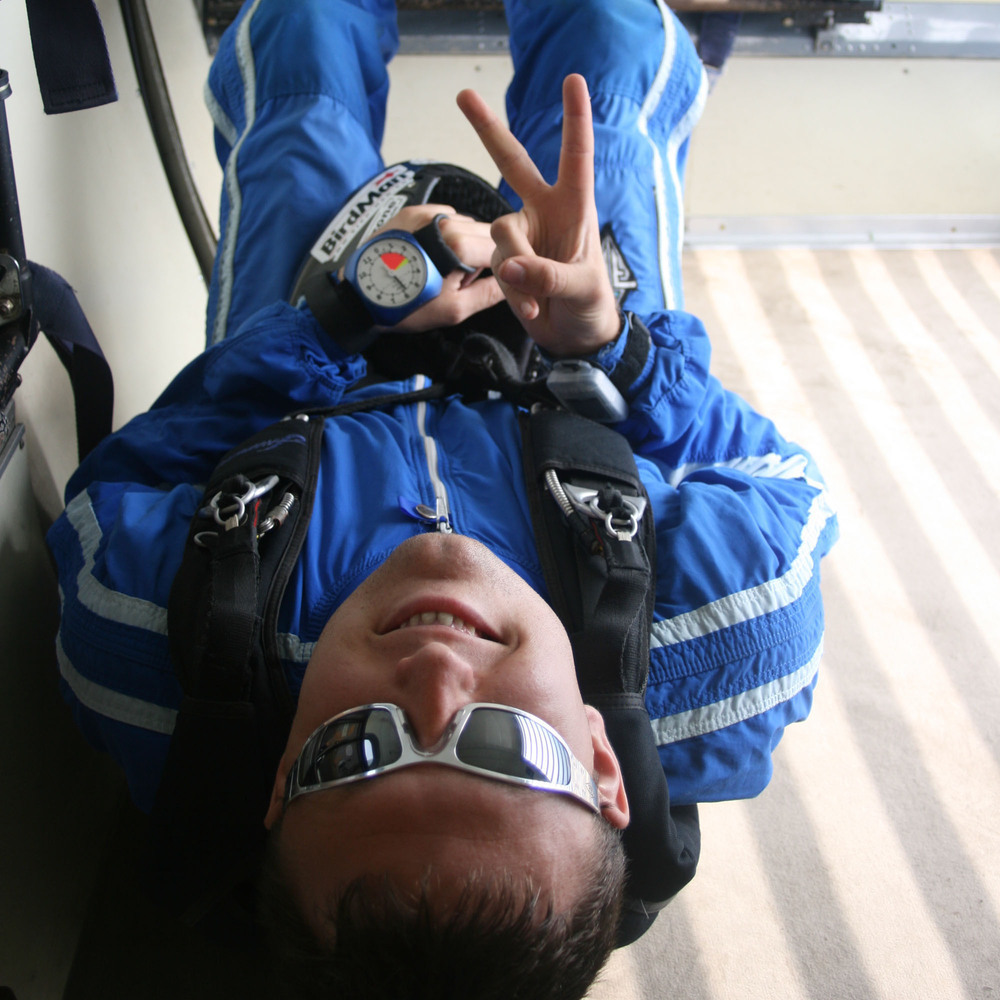Recommended Posts
dragon2 0
Also "funny": I'm allowed to jump a PD113R, as a reserve. However, I CAN'T try one out as a main, because it's smaller than 120 sqft!?!
ciel bleu,
Saskia
Nutz 0
Quote
Right. But if you are under a 230 instead of a 109, people will visit you in the hospital instead of the cemetary.
That is a rather extreme difference. I am talking about the difference between a 190 and a 230.
I think I could hook into the ground just as hard.
Yes. And for those that don't get it, that 230 may just save their lives.
I am never going to agree to more regulation. If anything we need less - not more.
sstovall 0
S
=
-some will fall in love with life and drink it from a fountain,
that is pouring like an avalanche coming down the mountain
MakeItHappen 15
IOW, as Wendy pointed out, Brian's chart says, in effect, that a 200 lb jumper at 1.6 'equals' a 100 lb jumper at 0.92. 'Equals' meaning the performance, ie turn rate, descent rate, toggle responsiveness etc are the same under these two conditions.
Performance iso-bars are conceptually represented in the attached figure.
Consider the curves labeled Perf. 1, 2 and 3 to mean High, Medium and Low, respectively.
We don't have this data. All we have is a few people that have jumped at several WL and their personal observations. What we need is actual data. Data from the 100 lb person jumping at several WLs as well as the 200 lb person jumping at several WLs.
Also this is simplified in that canopy type is not considered. We could also generate performance iso-bars among WL, canopy size and type of canopy.
Downsize progression is ill-defined too. The second figure represents several paths to downsizing. Most people have a 'step-function' progression in mind, ie increase WL by 0.1 for every 100 jumps. Is that really right? Does it fit the needs and skill acquisition of all jumpers?
Now, that chart with LOTS of numbers will not go over with the average jumper. What might be a better representation is a simple graph. Graph reading is slightly easier than following that table with numbers. See the third figure for an example.
What the actual curve on that graph is, is still open to debate.
.
Make It Happen
Parachute History
DiveMaker
billvon 2,402
>between a 190 and a 230.
Fair enough. So it will make the difference between a hospital bed and an ICU bed.
>I think I could hook into the ground just as hard.
Intentionally? You probably could. But everything else being equal, you will hit harder under a 190 than a 230 if you make the same mistake on both.
>If anything we need less - not more.
That's up to skydivers. If people stop downsizing so fast, and peopler stop dying under good canopies so often, then there will be no need for more regulation.. We have many choices - regulate ourselves, have USPA regulate us, or have the FAA regulate us. But "there should be no regulation at all!" is not an option.
grue 1
I'm loading my Fusion 210 at around a 1.2 or so, and if I were "forced" to upsize, I'd have to sell my rig, since the 210 is an extremely tight fit as it is. I suspect a lot of people are in the same situation.
peek 20
Thank you for continuing to point out why it is
It is not just wingloading, it is a number of variables that, when all are properly considered, would require a matrix (or chart) of numbers that would be impossible to understand.
We just need to convince these jumpers that are so eager to "downsize" that they should educate themselves about what these smaller canopies can do before getting one.
QuoteThis is why it appears that smaller jumpers are losing out
This is one of the biggest objections to these types of charts, everyone feels like they are losing out.
My thought have always leaned toward grandfathering in all the exosting jumpers, so nobody has to upsize, and the worst case scenario is that they have to put off downsizing for a few more jumps.
If everyone could see beyond themselves for a minute, and realize that if such a chart was put into practice, all new jumpers would be taught that this is the way we do it, and they won't feel as if they're losing out.
For example, I don't feel as if I'm losing out because I don't get to jump US military C-130s. There are bases all around here, and I see them flying all the time, and military folks do get to jump them, but not me. This doesn;t bother me becasue all I've ever known is that civilians don't get to jump from military AC, period.
What these new jumpers would be gaining however, is another layer of safety, hopefully keeping them mobile, and jumping for many years.
Judging by what many experienced jumpers are jumping, many of them would reach their maximum comfortable WL by the time they hit 700 or 800 jumps. A handful will want to load higher, and will have to wait just a bit longer ot get there, but lets be honest here, 1.5 is an aggressive WL, and you can do alot with it, and you can get there pretty quickly with the WL chart.
faulknerwn 36
Quote***
lets be honest here, 1.5 is an aggressive WL, and you can do alot with it, and you can get there pretty quickly with the WL chart.
Only if you're a bigger guy - small women at 500 jumps are still limited to a .9!!!!! wing loading - point 9 - that's a goofy restriction - big boys can load at .9 on their first jump - not just 500 jumps later. Absolutely smaller canopies are more responsive, but the large disparity in allowed wing-loadings is not right.
The key to remember is that small canopy does NOT mean radical. More than one 7-cell square is available below 100 square feet.
I had to chime in here on this one. I know it appears to be "cheating" the lighter jumpers out of getting their hands on a juicy 97 so they can be at a 1.2 lb/sf. The problem is, smaller parachutes are simply too radical in every way for a beginner to jump them at all. This is the reason why wing-loading is not the way to guide people to the right parachute. That is part of the equation, but we also need to take into account the fact that SIZE DOES MATTER.
A 120 is way tooo twitchy to start on, regardless of the wingloading.
+
Keynote Speaking:www.TranscendingFEAR.com
Canopies and Courses:www.BIGAIRSPORTZ.com
Nutz 0
I agree that lighter jumpers need to be at lower WLs in the beginning. Is it possible that a separate sliding scale needs to be devised for jumpers under 'x' weight?
Just as there are consessions for higher altitude DZ's, maybe the lighweights need some modification to their plan as they progress.
Lets face it, none of this will ever be a law, so following the chart will be an in-exact science. I know that including an exception will have all sorts of borderline jumpers looking to get on the smaller canopies, but i do have to admit, if .9 to 1 is the Wl for a smaller jumper with 500 jumps, thats just not right.
PhreeZone 15
And tomorrow is a mystery
Parachutemanuals.com
faulknerwn 36
Quote
A 120 is way tooo twitchy to start on, regardless of the wingloading.
+
I wouldn't put a person with 40 jumps on a 105, but a 100 lb girl who has 300 jumps on a Spectre 107? I think she's probably safer on that than the big boy jumping the Stilletto 150..
Back when I was learning to jump, I weighed in at about 115, and at about 50 jumps I went to Lake Wales with some friends. I didn't have any of my own gear, and PD was there at a booth. They started me on a Sabre 150 and after watching me on 1 jump, John Leblanc himself had me jumping a 135 and suggested that be the perfect size for my first canopy. I ended up finding a cheap Monarch 135 which I jumped for 50 jumps or so, then put another 50 on a friend's Jonathan 136, before buying a Jonathan 105 at around 200 jumps. Heck, I only had 6-700 jumps when you made me the Jedei 92.
But twitchy is such a relative term - if I had to land unconscious under a canopy right now - I'd take my Triathalon 99 in a heartbeat over a Samurai 120. I wouldn't even consider the Samurai - its a much more radical canopy despite its bigger size.
Using your chart, for a small woman - the only way she would be allowed to get more performance is switching from her Sabre2 120 to a Stilletto 120 or something similar - rather than switching to a Spectre 107. I find it hard to believe that someone could claim a Spectre 107 is twitchier than a 1 size up elliptical. I know a lot of women who really love the Spectres because they aren't twitchy and their openings are predictable, but they like the smaller sizes because they're easier to fly. So many options are being taken away from small people.
Its the reason I love 7-cells so much - I can get more speed by going smaller without getting the radical openings. I've got my share of spinning ellipticals and I hate it. Its why I've gone back to small 7-cells - I get most of the benefits of a higher wing-loading with much less of the risk.
Small != radical. Small can be radical, but they're not one and the same.
HydroGuy 0
QuoteJohn Leblanc himself had me jumping a 135 and suggested that be the perfect size for my first canopy.
Here are two quotes from John LeBlanc in the email I was sent.
QuoteThanks for the opportunity to comment. I am absolutely against
recommending a specific size, especially ones as small as you are
looking at for the light weight students and novices. We need to teach
people to choose a size that gives a sensible speed range for their
needs and desires.
QuoteI do think that 170 is still
pretty small for anyone exiting at 110 pounds, except the most youthful
people at a wide open sealevel DZ. The canopy is too zippy in that size,
even if it is not that fast at that wing loading.
Seems to me John is a driving force behind the lighter jumpers being pushed into larger canopies for a greater amount of jumps.
Seems to me John believes smaller canopies are more radical at lesser wing loadings.
Also notice, this is going by WEIGHT, not SEX. Smaller men will be hindered just as much as smaller women.
faulknerwn 36
Its weird - I remember very clearly back then much preferring to jump the PD 170 (F111) over the Sabre 150 (ZP) because the PD was much zippier. The 135's didn't worry me at all speed-wise - they were still quite slow. Only problem I had was packing the suckers. And this was years ago - I remember everyone thinking I was nuts for preferring the bigger F111 cuz it was faster and more fun.
Quote
Also notice, this is going by WEIGHT, not SEX. Smaller men will be hindered just as much as smaller women.
Perhaps by chromosome, instead of by sex?
Weight is causally related to sex in humans, although clearly not as tightly correlated as chromosomes. It's valid to consider the resultant consequence by sex.
According to wikipedia, the mean weights of north american adult women and men are 137 and 172 lbs, respectively.
rehmwa 2
QuoteIt's valid to consider the resultant consequence by sex.
Why, does the canopy fly different for a 115 pound man vs a 115 pound woman?
Here's some theories:
- a man's center of mass is a couple inches higher in the harness
- a woman can control an extra input by using their vaginas to hold one of the toggles
- canopies are impressed by a dick and, thus will "straighten up and fly right"
- women are softer and will handle impact better so can be more aggressive
- men have more arm hair so they have extra drag
etc.
ad nauseum
...
Driving is a one dimensional activity - a monkey can do it - being proud of your driving abilities is like being proud of being able to put on pants





.thumb.jpg.4bb795e2eaf21b8b300039a5e1ec7f92.jpg)




For example, I disagree with canopy sizes recommended for first-timers, especially heavier first-timers.
At our sea-level DZ, most first-timers start with 290s (Skymaster 290, Manta 290 or Solo 260) and stay with them until they have demonstrated a half-dozen decent landings (riser turns, etc.).
Ocassionally, we give a small (i.e. 120 pounds) student a Skymaster 230. .. and smaller students are usually flying Skymaster 230s by the time they graduate PFF (8 or 10 jumps).
However, If student weighs more than about 220 pounds, they get our big-boy rig (Goliath 340) and stay on it until they have demonstrated a bunch of good landings (rear riser flares, etc.).
Share this post
Link to post
Share on other sites